Secretary Mnuchin Explains the Details for Small Business Financial Relief
(Sundance) Treasury Secretary Steven Mnuchin explains some of details about how the CAREs Act provides financial relief for small businesses (0 to 500 employees). Mnuchin explains how the primary part of the relief bill will support approximately 50% of those impacted.
The Treasury Department has stood up a system inside the Small Business Administration that cuts through much of the bureaucracy. By using The Treasury Department lenders (local banks) as the point of contact for small businesses and The Treasury Department Treasury can backstop the process. The local business (or S-corp) takes their payroll and yearly expense documents to their local bank where they already have a relationship. As long as the bank is in the S-corp network; and because the emergency funds are distributed based on a good faith relationship; the bank gives the business or individual immediate access to funds (8 weeks of payroll and 25% of all operating expenses); the bank deposits in the business account. The FDIC guarantees the lender against any risk.
If the business does not continue payroll for the employees, the funds are considered a loan that must be repaid. However, if the business retains their employees (continues to keep current payroll); or -if needed- rehires any recent lay-offs using the funds provided; then the emergency loan becomes a grant the business will not have to repay. The system should be in place by this Friday.
The process is smart and can benefit the majority of Americans. What Trump/Mnuchin has put into place is an incentive, a no cost way, for employers to continue paying their employees instead of the employees using unemployment compensation.
Companies with 0 to 500 employees can access the Treasury funds through their local bank or credit union (FDIC Lender). As long as the company retains their employees, meaning continues to pay them, the loans do not have to be repaid.
This means small business employees get: (1) paid by their employer through July; and additionally, (2) those same employees are getting the coronavirus relief checks from the direct government assistance package [$1,200 per individual ($75k income) /$2,400 per couple ($150k income) plus $500 per child]. This should mitigate a great deal of financial hardship on U.S. workers.
Using the existing FDIC network to backstop and eliminate lender risk was a smart move and will speed up the process.






